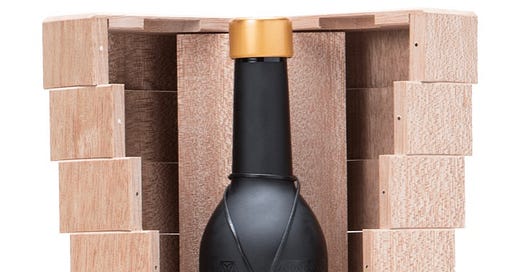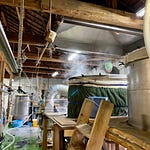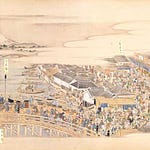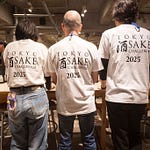Welcome to Issue 82 of SIN.
We hope this issue finds you well!
There’s a lot about innovation, technology and modernizing in this issue.
It seems that while tradition and history may be one of the attractions for some that are drawn to sake, it’s important to remember that nothing stays the same.
Sake, and the industry overall, is continually evolving.
This can be seen in a number of areas of the sake world such as new brewing techniques, modern flavor profiles, environmentally conscious brewing practices, marketing, and consumer interaction among others.
By and large these new paths being forged in the industry are positive steps that should be encouraged and celebrated. Sake, and the business of brewing, is an organic, growing industry that doesn’t, and shouldn’t, exist in a time capsule to be appreciated like some kind of ancient trade of the past, devoid of evolution and growth.
Enjoy the tradition and embrace the change.
And now for the news…
Shakers And Movers Recognized
Japan- According to the National Tax Authority, sake production has dropped by 27% in the last four years. Of course a large amount of this reduction can be attributed to COVID19 and the effect the pandemic had in creating an unstable market.
Amidst this difficult time a number of young kuramoto and tōji are making drastic changes to their approach. As part of a feature on business trends, the Nikkei recently consulted with six sake industry professionals to identify and rank breweries (using an undisclosed points system) that are leading the industry in innovation and considered worth keeping an eye on as affecters of change in the sake landscape. Like all rankings this one is best taken with a grain or two of salt, but is interesting nonetheless.
1. Asahi Shuzō (Yamaguchi Prefecture, Dassai)
The brewery has been busy developing its US brewery which will function in collaboration with a famous culinary school in New York. Asahi Shuzō is recognized as an ambassador in bringing sake to a global audience.
2. Niizawa Jōzōten (Miyagi Prefecture, Hakurakusei)
As mentioned in our story below, this brewery has continued to push the envelope in extreme rice milling in its goal to achieve the ultimate ginjō sake.
3. Yuchō (Nara Prefecture, Kaze no Mori)
Recognized for its continuing philosophy of combining traditional brewing methods originating in Nara Prefecture (bodaimoto) with modern methodologies to encourage the evolution of sake brewing.
4. Aramasa (Akita Prefecture, No.6)
Aramasa has been instrumental in the increased proliferation of wooden barrels (kioke) in brewing and even created a new division within the brewery for barrel construction.
5. Nanbu Bijin (Iwate Prefecture, Nanbu Bijin)
Nanbu Bijin was one of the first breweries to truly recognize the potential of the overseas market. More recently the brewery attracted attention when it developed technology for freezing namazake for export.
6. Fujii Shuzō (Hiroshima Prefecture, Ryūsei)
A rare example of a brewery that has converted entirely to kimoto production exclusively.
7. Senkin (Tochigi Prefecture, Senkin)
As proponents of the French “domaine” philosophy and brewers of kimoto sake made using airborne yeast exclusively, Senkin is recognized as an ambitious brewery.
8. Abe Shuzō (Niitaga Prefecture, Abe)
This brewery was selected for targeting the concept of producing sake that can be enjoyed throughout a meal from start to finish.
9. Chōshū Shuzō (Yamaguchi Prefecture, Tenbi)
A new enterprise built from a revived brewery in Shimonoseki, Yamaguchi. The Tenbi brand has proven very popular under toji, Miki Fujioka, formerly of Zaku and Kawatsuru.
10. Rice Wine (Kanagawa Prefecture, HINEMOS)
Narrowing the distance between brewery and consumer with direct delivery to customers.
11. Haccoba (Fukushima Prefecture, Hanauta Pops)
A brewery using a traditional, but unusual hanamoto method for its starter mash to make doburoku-style sake with additions of Japanese hops.
12. Hokusei Shuzō (Saitama Prefecture, Bunraku)
The current fifth generation kuramoto took the reins at age 32 and has taken the brewery through a complete overhaul renewing all of its brands.
12. Kangiku Meijō (Chiba, Fusa no Kangiku)
Brewing sake targeting the immediate local area by a young tōji who assumed the position at age 25 after working as an engineer at an airline company. The concept behind the OCEAN99 series, which is brewed to express the changing seasonal climate of the Kujūkuri coast near the brewery, was cited by judges as an innovative concept.
JG: What an interesting list of categories. In truth, I think that there are likely countless more kura doing similarly interesting things all over Japan, and that there is no end to this kind of survey. It does, however, seem to focus on recently popular companies rather than take a wide view of all that is out there, so there’s that… But I like how a list like this sheds light upon how interesting and diverse the sake-brewing world is. I hope they continue this kind of list and publish it from time to time.
寒菊銘醸 , 西酒造 (富乃宝山) , 重山酒造 (横山五十) , 旭酒造 (獺祭) , 新澤醸造店 (伯楽星), 油長酒造 (風の森), 新正酒造 (No.6), 南部美人 (南部美人) ,せんきん (仙禽) , 藤井酒造 (龍勢) , 阿部酒造 (あべ) , 長州酒造 (天美) , Rice Wine (HINEMOS) , Haccoba (はなうたホップス) , 北西酒造 (文楽) ,寒菊銘醸 (総の寒菊)
Source - Xtrend
AI Finding Fish In Fukushima
Fukushima- Suzuki Shuzō (maker of Iwaki Kotobuki) has used AI technology to develop a line of sake specially designed to pair with local fish varieties, known as jobanmono.
Sake was developed to match with eight varieties of fish including flounder, monkfish, and sardines.
The sake was developed with the hope of supporting the fishing industry in Fukushima Prefecture, which is affected by concerns regarding the safety of the water in the region as the government announced plans to release treated radioactive water from the Fukushima Daiichi Nuclear Power Plant into the ocean.
A Tokyo-based venture company developed a special sensor that uses AI technology to analyze the umami, and other flavor components of the fish and then quantify their compatibility with sake. The compatibility was graded with each of the selected sake scoring more than 90 points out of 100, with bonito (katsuo) in particular scoring the highest at 97.2 points.
Source - NHK
(JG: In lieu of comments here, please see my longer article at the end of this newsletter, in which I address this.)
鈴木酒造 (磐城壽)
How Much Is Too Much?
Miyagi- In news that will excite some and induce eye-rolling and utter indifference in others, Niizawa Jōzōten has apparently broken its own seimaibuai record to create Rei Kyō-Crystal Zero.
The current average milling ratio in the industry is 63.4%. As readers will know, daiginjō-grade sake needs to be milled to at least 50%, which usually takes anywhere between two to three days for the milling process to be complete.
Listen to this episode with a 7-day free trial
Subscribe to Sake Industry News to listen to this post and get 7 days of free access to the full post archives.












